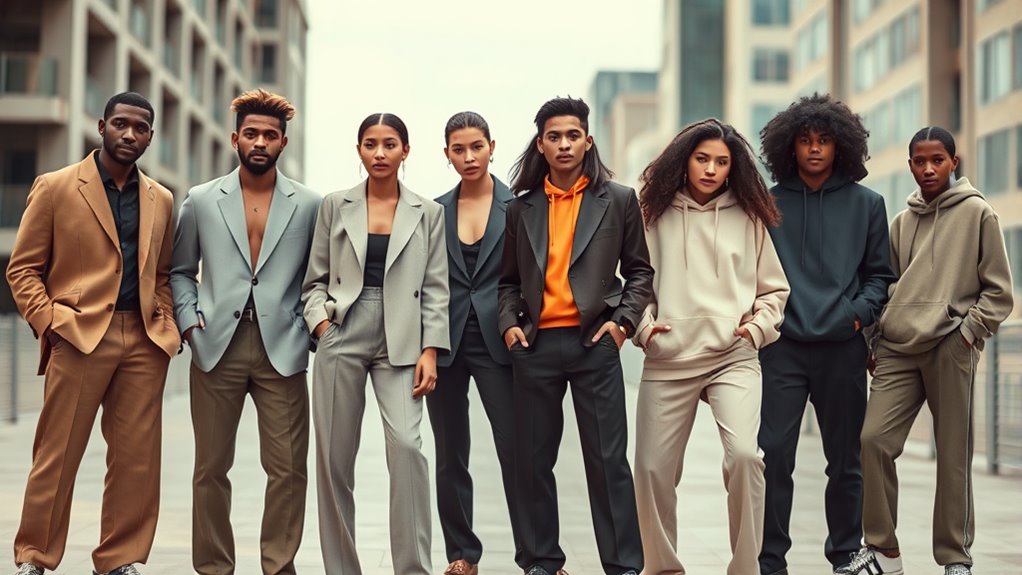Gender-neutral fashion breaks traditional boundaries by embracing styles that are inclusive and expressive beyond gender norms. It has roots in history, from the 1920s to today’s movements promoting comfort, versatility, and societal progress. Brands now prioritize designs that empower personal identity, moving away from rigid stereotypes. This shift reflects a broader cultural push toward equality and acceptance. If you explore further, you’ll discover how these styles continue to evolve and influence modern fashion.
Key Takeaways
- Historically, clothing signified social status and gender, with gradual shifts towards more fluid styles starting in the early 20th century.
- The 1980s and 1990s saw designers and icons challenge gender norms with androgynous, unisex, and versatile fashion choices.
- Sustainable fashion has promoted gender-neutral clothing by emphasizing comfort, practicality, and inclusive designs over traditional stereotypes.
- Modern mainstream fashion emphasizes inclusivity, comfort, and personal expression, making gender-neutral styles widely accessible.
- The shift in fashion reflects societal progress toward gender equality, using clothing as a tool for self-expression and social change.

Gender-neutral fashion is transforming the way we think about clothing by embracing styles that break traditional gender boundaries. To truly understand where this movement is headed, it helps to look back at its history evolution. Over the decades, fashion has always reflected societal changes, but the idea of clothing specific to one gender has been a longstanding norm. Historically, clothing was a marker of social status, culture, and identity, often strictly divided along gender lines. Men wore tailored suits, while women donned dresses and skirts, with little room for crossover. Yet, even in these early times, there were moments when boundaries blurred—such as in the 1920s, when flapper dresses challenged traditional femininity, or during the 1960s and 70s, when unisex styles gained popularity as symbols of rebellion and freedom. These shifts marked the beginning of a slow but steady evolution toward more fluid notions of gendered clothing.
As you trace the history progression, you notice that the 1980s and 90s saw designers experimenting more openly with genderless fashion. Labels started creating collections that featured oversized silhouettes, neutral colors, and versatile pieces that could be worn by anyone, regardless of gender. This was also the era when the concept of androgyny gained mainstream attention, thanks to icons like David Bowie and Prince, who embodied styles that defied traditional gender norms. The rise of sustainable fashion has further supported this movement by encouraging brands to prioritize comfort and versatility over rigid gender stereotypes. Fast forward to today, and gender-neutral fashion has become more accessible and mainstream, driven by a desire for inclusivity and self-expression. Brands are now designing collections that focus on comfort, versatility, and individual identity, rather than conforming to outdated stereotypes.
This history progression shows you how far we’ve come from rigid, gender-specific clothing to a more open, accepting approach. It’s no longer about fitting into predefined boxes, but about creating a wardrobe that reflects your unique personality. The ongoing shift is fueled by a broader cultural movement toward gender equality and acceptance, making it easier for you to explore styles that resonate with you personally. As society continues to challenge binary ideas, fashion is evolving to become more inclusive, giving you the freedom to choose clothing that feels authentic to who you are—without being confined by traditional gender expectations. The history progression of gender-neutral fashion is a testament to how clothing can be a powerful tool for self-expression and societal change.
Frequently Asked Questions
How Do Gender-Neutral Fashion Trends Vary Across Different Cultures?
The current question explores how gender-neutral fashion trends vary across cultures. You’ll notice that cultural expressions greatly influence fashion diversity, shaping styles that challenge traditional gender norms. In some societies, gender-neutral clothing blends seamlessly with local customs, while others emphasize distinct gender roles. By understanding these differences, you can appreciate how cultural context shapes gender-neutral fashion, creating a rich tapestry of style that reflects diverse identities worldwide.
What Are the Most Sustainable Materials Used in Gender-Neutral Clothing?
When choosing sustainable fabrics for gender-neutral clothing, you’ll find options like organic cotton, hemp, and Tencel that reduce environmental impact. Eco-friendly dyes, such as plant-based or low-impact dyes, further minimize pollution. By selecting these materials, you actively support sustainability and reduce your carbon footprint. Incorporating these fabrics and dyes into your wardrobe helps promote eco-conscious fashion, making a positive difference for the planet while embracing versatile, gender-neutral styles.
How Can Retailers Effectively Market Gender-Neutral Fashion to Diverse Audiences?
Think of marketing strategies like a bridge connecting you to a diverse audience. To effectively market gender-neutral fashion, identify your target audience’s values and preferences, then craft inclusive messages that resonate. Use social media, influencer collaborations, and visually diverse campaigns to showcase versatility. By embracing authenticity and inclusivity, you create a welcoming space where everyone feels represented and inspired, ultimately expanding your reach in this evolving fashion landscape.
What Challenges Do Designers Face When Creating Gender-Neutral Collections?
When designing gender-neutral collections, you face branding challenges that can make it hard to appeal universally. Standardizing sizing becomes tricky because you need flexible options that suit all body types without alienating any group. You might also struggle with communicating the concept clearly, ensuring your message resonates across diverse audiences. Balancing inclusivity with distinctive branding requires thoughtful planning, creativity, and a willingness to push traditional fashion boundaries.
How Does Gender-Neutral Fashion Influence Traditional Beauty Standards?
You see that gender-neutral fashion challenges traditional beauty standards by blending masculine aesthetics with feminine expressions, encouraging a broader appreciation of diverse identities. This movement shifts focus away from rigid gender roles, allowing individuals to explore styles that resonate with their personal identity. As you embrace these designs, you help break down stereotypes, fostering a more inclusive view of beauty that celebrates all expressions beyond conventional norms.
Conclusion
As you embrace gender-neutral fashion, you’re helping to break down stereotypes and create a more inclusive world. Did you know that 63% of young adults now support gender-neutral clothing options? This shift shows more people are ready to challenge traditional norms and celebrate individual expression. By choosing styles that transcend gender, you’re not just making a fashion statement—you’re contributing to a future where everyone feels free to be themselves.










